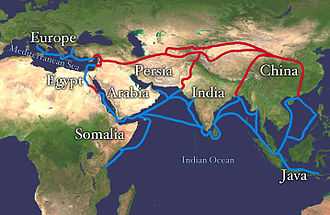Smuggling of silkworm eggs into the Byzantine Empire
 The Silk Road | |
| Date | Mid-6th century (552/563 AD) |
|---|---|
| Location | Central Asia |
| Participants | Two monks |
| Outcome | Establishment of Byzantine silk industry |
In the mid-6th century AD, two monks, with the support of the Byzantine emperor Justinian I, successfully smuggled silkworm eggs into the Byzantine Empire, which led to the establishment of an indigenous Byzantine silk industry. This acquisition of silk worms from China allowed the Byzantines to have a monopoly of silk in Europe.[1]
Background

Silk, which was first produced sometime during the fourth millennium BC by the Chinese, was a valuable trade commodity along the Silk Road.[2] By the first century AD, there was a steady flow of silk into the Roman Empire.[2] With the rise of the Sassanid Empire and the subsequent Roman–Persian Wars, importing silk to Europe was increasingly difficult and expensive. The Persians strictly controlled trade in their territory and would suspend trade in times of war.[3] Consequently, the Byzantine Emperor Justinian I, tried creating alternative trade routes to Sogdiana, which at the time had become a major silk-producing centre:[4] one to the north via the Crimea, and one to the south via Ethiopia.[5] The failure of these efforts led Justinian I to look elsewhere.
Expedition
.jpg)
Two unidentified monks (most likely members of the Nestorian Church[2][5]) who had been preaching Christianity in India, made their way to China by 551 AD.[6] While they were in China, they observed the intricate methods for raising silk worms and producing silk.[6] This was a key development, as the Byzantines had previously thought silk was made in India.[7] In 552 AD, the two monks sought out Justinian I.[5] In return for his generous but unknown promises, the monks agreed to acquire silk worms from China.[4] They most likely traveled a northern route along the Black Sea, taking them through the Transcaucasus and the Caspian Sea.[1]
Since adult silkworms are rather fragile and have to be constantly kept at an ideal temperature, lest they perish,[8] they utilized their contacts in Sogdiana to smuggle out silkworm eggs or very young larvae instead, which they hid within their bamboo canes.[1][5] Mulberry bushes, which are required for silkworms, were either given to the monks or already imported into the Byzantine Empire.[1] All in all, it is estimated that the entire expedition lasted two years.[9]
Impact
Shortly after the expedition there were silk factories in Constantinople, Beirut, Antioch, Tyre, and Thebes.[5] The acquired silk worms allowed the Byzantine Empire to have a silk monopoly in Europe. The acquisition also broke the Chinese and Persian silk monopolies.[1] The resulting monopoly was the foundation for the Byzantine economy for the next 650 years until its demise in 1204.[10] Silk clothes, especially those dyed in imperial purple, were almost always reserved for the elite in Byzantium, and their wearing was codified in sumptuary laws.[2] Silk production in the region around Constantinople, particularly in Thrace in northern Greece, has continued to the present.
Sources
- ↑ 1.0 1.1 1.2 1.3 1.4 Patrick Hunt. "Late Roman Silk: Smuggling and Espionage in the 6th Century CE". Stanford University. Retrieved 20 April 2013.
- ↑ 2.0 2.1 2.2 2.3 "Silk". University of Washington. Retrieved 20 April 2013.
- ↑ Norwich, John (1988), Byzantium: The Early Centuries pg. 265
- ↑ 4.0 4.1 Clare, Israel (1906), Library of Universal History: Mediaeval History pg. 1590
- ↑ 5.0 5.1 5.2 5.3 5.4 Norwich, pg. 266
- ↑ 6.0 6.1 Clare, pg. 1589
- ↑ Clare, pg. 1587
- ↑ The Smithsonian on Silk Production
- ↑ Silk Museum of Lebanon
- ↑ Muthesius, Anna (2003), Silk in the Medieval World pg. 326
